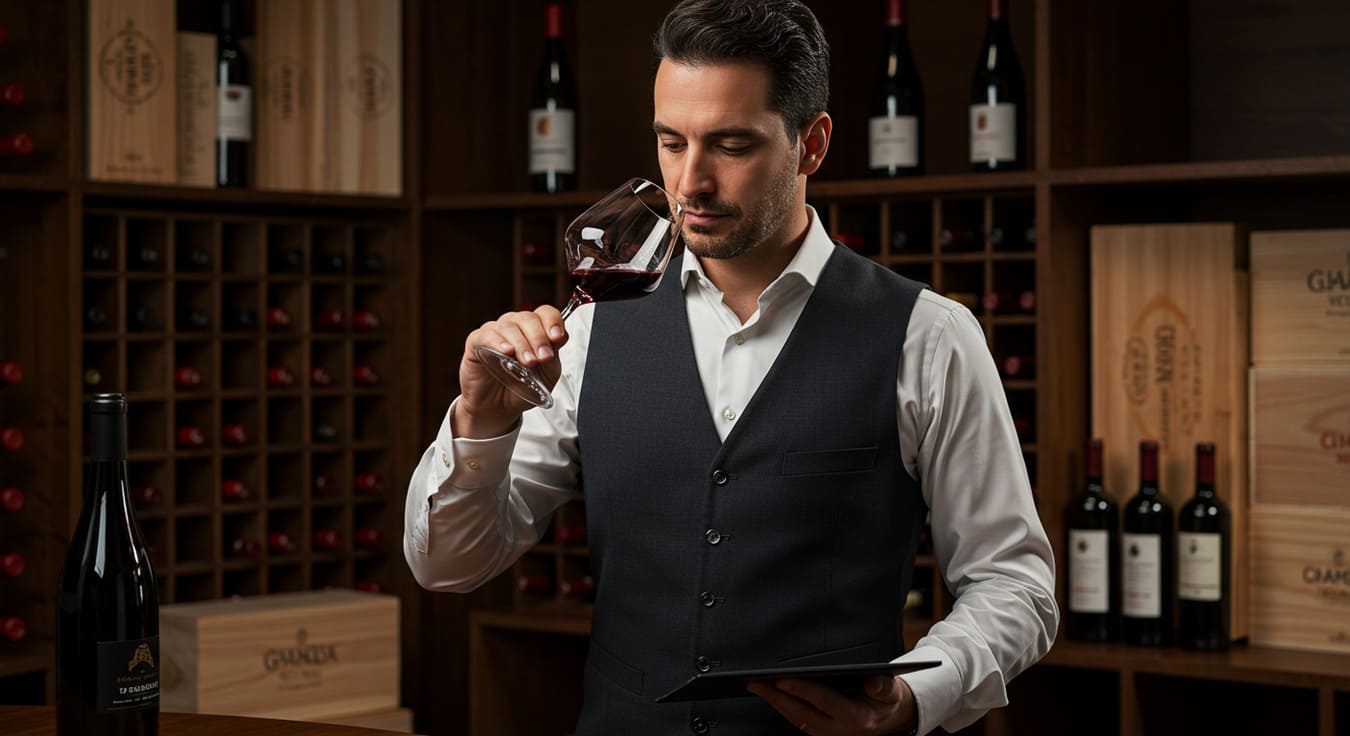Wine Taste Testing

Wine isn’t just liquid in a glass.
It’s that moment when you proposed to your wife. That celebration when you crushed your sales target. That Sunday dinner with Mom that turned into a three-hour life confession.
… And yet most wine brands still think a Survey Monkey questionnaire can capture this magic. They’re dead wrong.
This isn’t opinion. It’s fact.
Table of Contents
✅ Listen to this PODCAST EPISODE here:
What Is Wine Taste Testing?
Professional wine taste testing is ruthlessly structured sensory research designed to bypass the conscious mind and capture how human beings actually interact with wine. Not how they think they should. Not how they pretend to. But how they genuinely, viscerally respond when nobody’s watching their performance.
So, wine taste testing is methodical evaluation conducted in controlled environments to assess quality, market potential, and competitive positioning. It’s the difference between what people say at a dinner party versus what makes them unconsciously reach for a second glass when nobody’s looking.
The Two Worlds That Never Meet
The wine taste testing universe splits into two completely different galaxies:
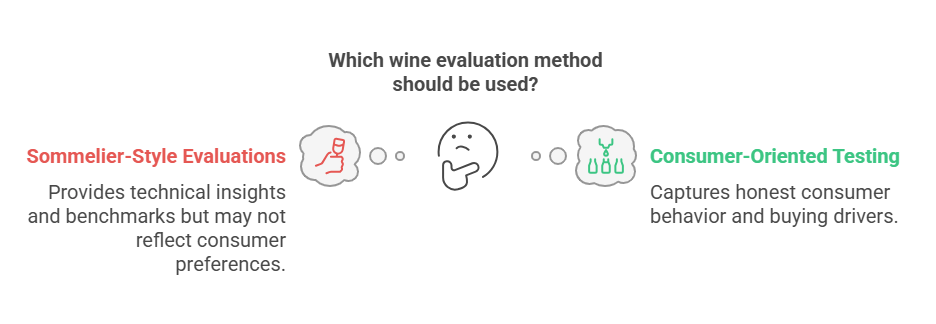
Sommelier-Style Evaluations: This is the world of technical wine geeks evaluating against established benchmarks. Think Wine Spectator scores and competition medals. Useful? Sure… But about as representative of normal humans as a NASA launch protocol is to your morning routine.
Consumer-Oriented Wine Taste Testing: Regular people – not “experts” – participate in structured tastings designed to catch them in the act of being honest. This approach exposes what actually drives buying behavior rather than what wine critics with agendas and advertisers want to believe.
For example, a luxury hotel chain learned this distinction through a harsh experience. Their sommelier-selected house wines were critically acclaimed masterpieces that guests barely touched. Comprehensive wine tasting with actual guests (not wine professionals) revealed an awkward truth: those sophisticated, terroir-driven wines that critics adored were actively alienating typical guests who secretly yearned for more obvious fruit and a softer finish. The hotel switched its program based on wine taste testing data, not expert opinions, and saw by-the-glass sales rocket up 42% in three months.
Why Wine Testing Breaks All the Rules
Wine taste testing requires specialized approaches because:
- Wine contains 200+ aromatic compounds creating sensory experiences as complex as human emotions
- Cultural associations hijack perception in ways unique to wine (ever seen someone swear a $100 wine tastes better than the same wine at $20? Wine taste testing catches this embarrassing human glitch)
- Temperature shifts of just 5°F create entirely different tasting experiences
- Wine evolves in the glass minute by minute, demanding multiple evaluation points
The Science of the Sip: How Wine Is Actually Evaluated
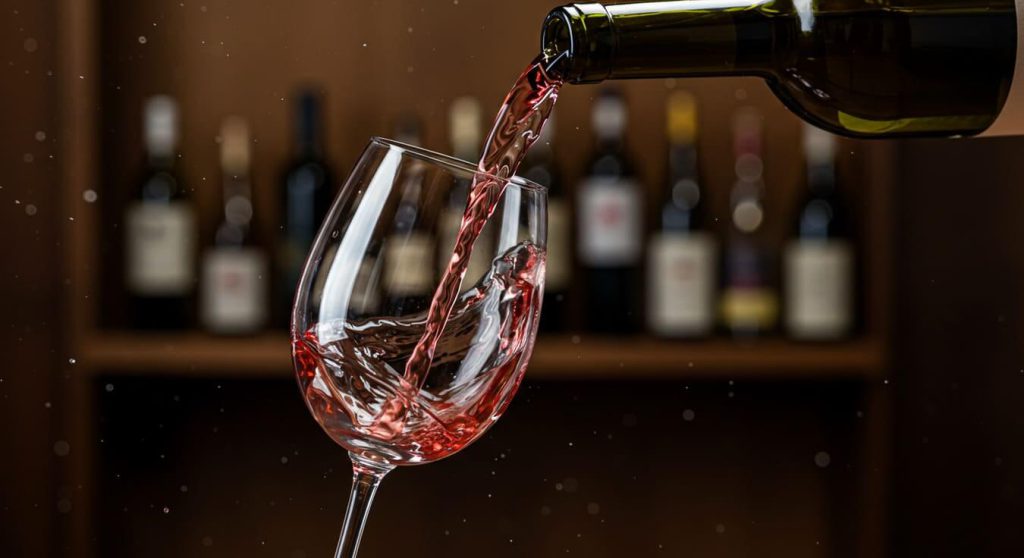
This methodical process breaks down wine’s complex experience into components that reveal exactly where your product connects or fails with consumers. Here’s how wine taste testing dissects the experience that casual sippers will never consciously understand:
Appearance: The 3-Second Judgment That Kills Most Wines
Wine taste testing begins before the liquid touches a single lip:
- Clarity and brilliance: Is there a vibrant reflective quality or dull murkiness?
- Color and depth: The precise hue reveals age, grape variety, and production methods
- Viscosity: Those “legs” running down the glass expose alcohol and glycerol levels that predict mouthfeel
Aroma: Where 80% of “Taste” Actually Happens
The dirty secret sommeliers don’t tell you: smell is where the real action happens. In wine taste testing, aroma evaluation gets brutally segmented:
- Primary aromas: Fruit, floral, and herb notes directly from the grape
- Secondary aromas: Fermentation-derived scents (bread, yogurt, butter)
- Tertiary aromas: Aging-derived characteristics (vanilla, tobacco, leather)
- Bouquet: The combined aromatic fingerprint these elements create together
Wine taste testing for a major retailer’s private label program exposed something their marketing team refused to believe: their target consumers couldn’t identify specific aromatic compounds, but they responded with unmistakable physical pleasure to wines with pronounced stone fruit aromas. These consumers literally couldn’t articulate what they were responding to, but their bodies gave them away. The retailer sourced wines matching this aromatic profile and crushed competitors by 31% in subsequent blind tests.
Taste: The Battlefield of Opposing Forces
Wine taste testing on the palate isn’t about “good” or “bad” – it’s about the tension between competing elements:
- Sweetness: Both actual sugar levels and perceived fruit ripeness
- Acidity: The electric current that either energizes or assaults the palate
- Tannins: Those mouth-drying compounds that create either structure or sandpaper
- Alcohol: The heat and body that either supports or dominates the experience
Mouthfeel: The Dimension Amateur Hour Misses Completely
Regular consumers rarely articulate this dimension, but wine taste testing reveals it drives purchase decisions enormously:
- Body: The weight and presence (light, medium, full)
- Texture: The tactile sensation (silky, grainy, plush, coarse)
- Temperature perception: How the wine feels temperature-wise regardless of actual serving temperature Astringency: The drying, tissue-paper sensation from tannins and acid
For example, an Australian producer watched in shock during wine taste testing as consumers rated their new release highly on flavor but unconsciously grimaced at its aggressive textural astringency. Nobody mentioned this issue in written feedback. A simple filtration adjustment softened the mouthfeel without altering flavor compounds. The modified version outsold the original by 58% in test markets – all because wine taste testing caught what consumers felt but couldn’t express.
Finish: The Last Impression That Decides Everything
Professional wine taste testing obsesses over how wine leaves the palate:
- Length: How many seconds flavor impressions persist (3-5 is average, 10+ is exceptional)
- Evolution: How flavors transform during the finish
- Quality: Whether final impressions delight or disappoint
- Complexity: How many distinct elements appear during the fadeout
💡 The Subconscious Responses That Actually Predict Sales
Here’s the million-dollar insight: what consumers say during wine taste testing often means nothing compared to what their bodies reveal.
Professional wine taste testing captures the tells consumers don’t even know they’re giving away:
• Micro-expressions flashing across faces in 1/15 of a second • Postural shifts that signal engagement or rejection • Glass-lifting behaviors that expose genuine interest levels • Language switching from analytical to emotional as engagement deepens
A prestigious Champagne house ran wine taste testing where participants insisted they preferred “sophisticated dryness” in their bubbly. Their unconscious behaviors exposed this as complete fiction. When dosage (added sugar) increased by just 2g/L – a change technically imperceptible to most palates – positive micro-expressions spiked by 34%, and glass-lifting frequency jumped by 41%.
These participants were literally lying – not maliciously, but because they didn’t know their own preferences. This explains why proper wine taste testing goes beyond asking questions. In wine, your body knows what you want before your conscious mind catches up.
Sensory + Emotional Feedback: Where the Real Money Gets Made
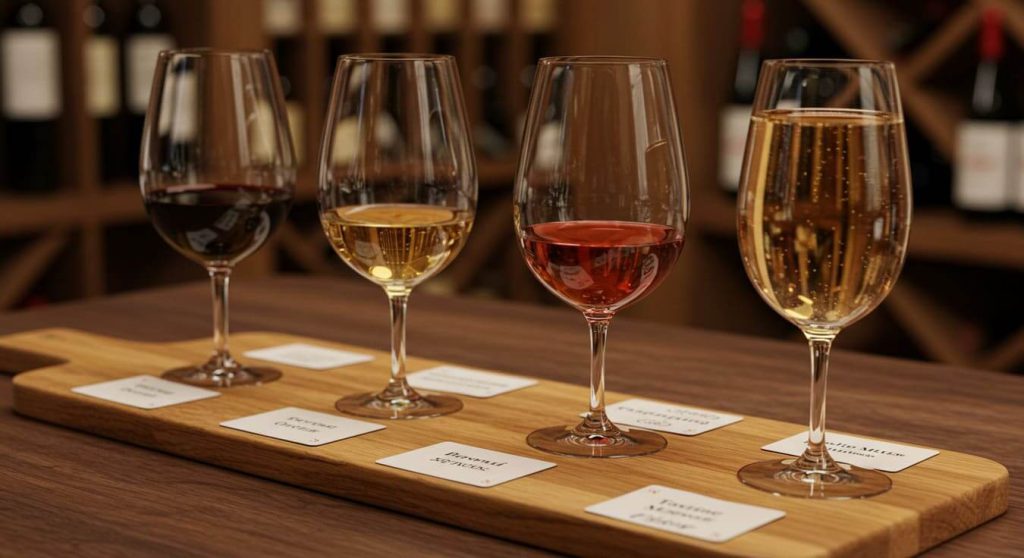
Wine isn’t a beverage. It’s an emotional experience poured into a glass.
The most valuable insights from wine taste testing come from watching what happens between sips – not from what people say when directly questioned:
• Facial micro-tensions when tannins hit too hard (even when consumers praise the wine’s “structure”)
• Pupil dilation at first sip (revealing subconscious arousal – positive or negative)
• That half-second hesitation before swallowing (the instant of doubt that kills repurchase)
• The almost magnetic reach for another taste (the strongest buying signal humans give)
A boutique Oregon producer was completely baffled when their 94-point Pinot Noir collected dust on shelves despite glowing reviews. Comprehensive wine taste testing exposed the uncomfortable truth: 72% of participants displayed subtle negative facial reactions to the wine’s prominent earthy character, despite verbally praising its “complexity” and “authenticity.” The winery adjusted their winemaking to retain complexity while softening the earthy notes. The reformulated wine flew off shelves – 51% sales increase with zero marketing changes.
The Memory Triggers Worth Millions
Nobody remembers specifications. Everyone remembers how you made them feel.
The holy grail moments in wine taste testing happen when participants spontaneously make emotional connections:
“This instantly took me back to my grandfather’s beach house…”
“I immediately pictured the Italian restaurant where my husband proposed…”
“This tastes exactly like the vacation where we got snowed in at that cabin…”
These emotional links aren’t cute anecdotes – they’re marketing goldmines.
The Role of Technology in Wine Testing: When Machines Expose Human Lies
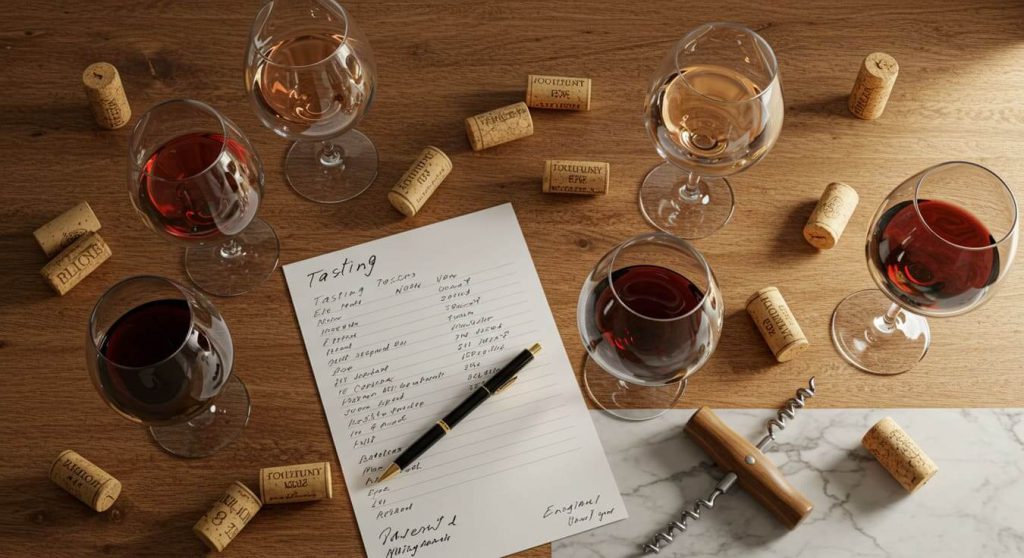
The marriage of ancient sensory evaluation with technology has transformed wine taste testing. This is about catching what even the best human observers miss.
The Truth Your Customers Will Never Admit
Numbers lie. Emotions don’t.
Most wine drinkers can’t explain why they like what they like. They lack the vocabulary, the confidence, or most commonly, the self-awareness to articulate what drives their choices.
- AI-assisted sentiment analysis during wine taste testing now exposes what participants themselves don’t recognize:
- Enthusiasm hiding behind technical jargon
- Hesitation buried under positive vocabulary
- Confusion masquerading as contemplation
- True excitement versus social performance
A premium wine club deployed this technology during wine taste testing for their quarterly selections. Standard analysis showed two Syrahs scoring virtually identically (7.3 vs 7.4/10). Sentiment analysis of the same sessions exposed one wine generating 42% higher positive emotional language despite nearly identical numerical ratings. The emotionally preferred wine was selected and delivered 68% higher member satisfaction scores than previous shipments.
The 7,000 Expressions Your Face Can’t Hide
Your face reveals what your words conceal.
Your face betrays you constantly. The human face produces thousands of distinct expressions – most happening unconsciously in milliseconds. Facial coding systems in wine taste testing now capture these revealing micro-reactions:
- Disgust responses (often lasting just 1/20th of a second) to excessive oak or alcohol
- Genuine pleasure versus polite appreciation (the difference is stark when measured)
- Confusion when experiencing unfamiliar profiles (often disguised verbally as “interesting”)
- Surprise (both delighted and disappointed) at first sip
Eye-Tracking: Where Attention Goes Before Decisions Flow
In packaging development, eye-tracking technology has transformed wine taste testing by exposing exactly how consumers interact visually with wine:
- Which label elements grab attention first, second, and third
- Where consumer attention dwells versus skims
- Whether critical information actually gets seen
- Where confusion or hesitation happens during visual processing
Case Study: How Wine Taste Testing Saved a Legendary Brand from Death
Sometimes the most valuable wine taste testing insights come from what isn’t said – and what wouldn’t be discovered without professional observation.
A renowned Napa Valley producer faced a terrifying reality: their flagship Cabernet Sauvignon – representing 68% of total revenue – was experiencing declining sales despite consistent critical acclaim. The situation was approaching existential threat level.
Digital surveys provided zero useful insights. Consumers rated the wine exceptionally highly (8.7/10) and described it with glowing language. Focus groups yielded equally useless feedback, with participants enthusiastically praising the wine’s quality and pedigree.
Based on this traditional research, the brand might have concluded that its issues were distribution-related rather than product-based. They would have been catastrophically wrong.
The Moment of Truth
The breakthrough came during comprehensive wine taste testing conducted across three markets with their target demographic: affluent wine enthusiasts aged 35-55.
Trained observers noticed something digital surveys completely missed: participants consistently displayed subtle negative physical reactions during their first taste – a momentary tensing of facial muscles followed by a slight hesitation before swallowing – despite verbally praising the wine seconds later.
When moderators specifically probed this disconnect, they uncovered the million-dollar insight: 72% of participants found the wine impressive but intimidating. The technical precision of the wine was being read as “unapproachable” and “not suitable for casual enjoyment.”
As one participant finally admitted after careful probing: “It’s the kind of wine I’d serve to impress my boss, not to enjoy with friends on a Friday night.”
The Market-Validated Miracle
The results were stunning: • The new “everyday” Cabernet achieved distribution targets 43% faster than projected • Cannibalization of the flagship was minimal (less than 7%) • Total brand revenue increased 34% within 18 months • Brand household penetration grew by 27% • Most importantly, flagship sales stabilized and returned to growth.
The lesson is brutal but clear: in wine, technical excellence without emotional connection is a precarious position. Only thorough wine taste testing revealing both the spoken and unspoken responses can provide the complete picture brands need to thrive in this uniquely emotional category.
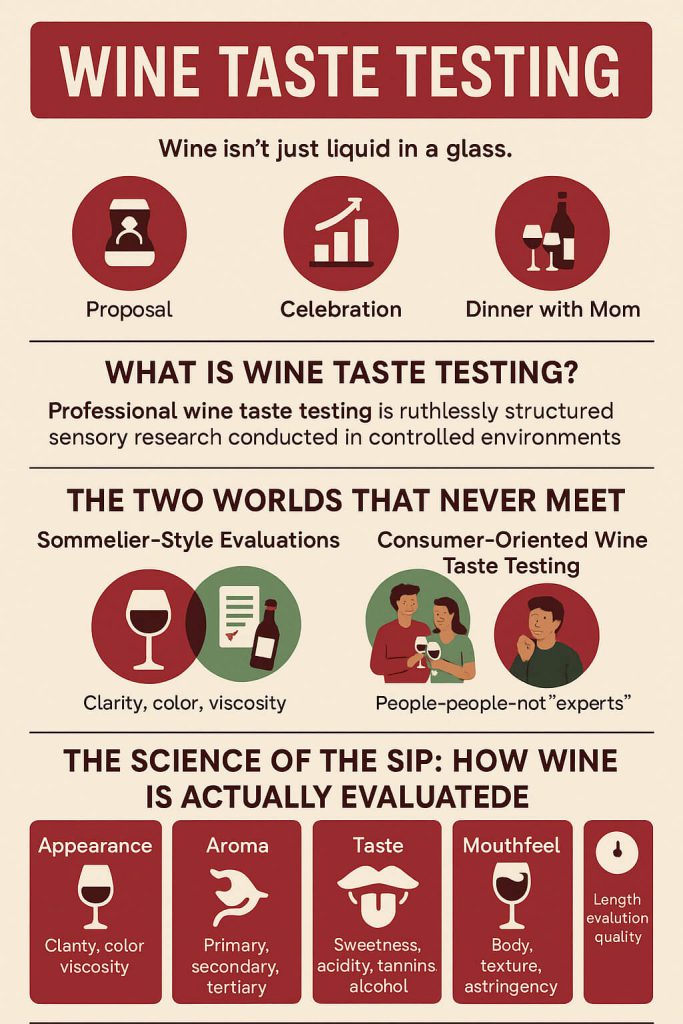
Key Insights:
✅ Beyond Words: Wine taste testing captures the 93% of communication that’s non-verbal, exposing the massive gap between what consumers say and how they actually respond.
✅ Environmental Control: Professional wine taste testing eliminates the variables that corrupt data reliability – temperature, glassware, lighting, competing aromas – ensuring you’re measuring wine reactions, not random environmental noise.
✅ The Observation Edge: Trained moderators detect micro-expressions, body language shifts, and emotional responses that digital surveys will never capture in a million years.
✅ Sensory Completeness: Wine taste testing evaluates the complete experience from visual appeal through aroma, taste, texture, and finish – impossible to assess through other methods.
✅Emotional Mapping: Only professional wine taste testing effectively captures the emotional associations and memory triggers that often drive purchase decisions more powerfully than rational evaluation.
✅Competitive Context: Side-by-side evaluation in controlled settings reveals positioning insights that isolated assessments miss entirely.
✅Technology Enhancement: Modern wine taste testing combines traditional expertise with cutting-edge tools like facial coding, sentiment analysis, and biometric monitoring for unprecedented insight depth.
✅ The Confidence Factor: Wine taste testing uniquely reveals consumer comfort level with products – a critical factor in categories where social risk influences purchase decisions.
✅Risk Reduction: Professional wine taste testing significantly reduces the likelihood of costly market failures by identifying issues that are impossible to detect through other methodologies.
What Makes SIS International a Top Wine Taste Testing Partner?
SIS International stands out as a premier wine tasting partner through a combination of specialized expertise, global capabilities, and methodological innovation. Here’s why leading wine brands trust SIS International for their most critical research needs:
• CUSTOMIZED APPROACH: SIS designs wine taste testing protocols specific to your business questions, not one-size-fits-all methodologies. SIS tailors every aspect of research design to deliver actionable insights for your specific challenge.
• THE 40+ YEARS OF EXPERIENCE: Since 1984, SIS International has conducted wine taste testing across price points, varietals, and markets—building unparalleled category expertise. This institutional knowledge means SIS researchers understand the subtle nuances and historical context that influence wine perception and can interpret findings within the appropriate competitive framework.
• THE GLOBAL DATABASES FOR RECRUITMENT: SIS maintains specialized panels of wine consumers across 47 countries, segmented by consumption frequency, price point preferences, and category engagement. This proprietary recruitment capability ensures your wine taste testing includes precisely the right participants—from everyday wine drinkers to category enthusiasts—depending on your target market.
• PROJECTS GET DONE FAST: SIS International’s dedicated wine taste testing facilities in key markets enable rapid deployment of research protocols. From initial brief to final report, SIS typically delivers complete projects 37% faster than general market research providers, with express options available for time-sensitive product decisions.
• AFFORDABLE RESEARCH: SIS International’s efficient methodologies and purpose-built facilities keep wine taste testing accessible for producers of all sizes. Modular research designs allow brands to select precisely the insights they need without unnecessary components, with pricing typically 22-31% below comparable specialty research providers.
• TECHNOLOGICAL INTEGRATION: SIS International’s wine taste testing incorporates advanced tools including AI-assisted sentiment analysis, facial coding technology, and biometric response measurement—all integrated with traditional sensory evaluation to provide unprecedented insight depth and accuracy.
• ACTIONABLE RECOMMENDATIONS: Unlike firms that simply deliver data, SIS International’s wine category experts translate research findings into clear, specific recommendations that directly address your business objectives.
Frequently Asked Questions About Wine Taste Testing
How is professional wine taste testing different from a casual wine tasting?
Wine taste testing follows ruthlessly strict protocols designed to eliminate variables and expose reality. Unlike casual tastings, proper wine taste testing controls everything from serving temperature to lighting conditions, uses standardized evaluation procedures, and often incorporates technologies like facial coding and sentiment analysis.
Most crucially, professional wine taste testing captures both explicit feedback and implicit reactions – not just what consumers say but what their bodies reveal. The difference is like comparing a casual chat about politics versus a polygraph test – one gives you opinions, the other exposes truth.
What types of business questions can wine taste testing help answer?
Wine taste testing provides critical answers for numerous business decisions including:
- Product development (optimizing blends before production)
- Competitive positioning (understanding how you truly stack up)
- Pricing strategy (identifying where perceived value breaks down)
- Packaging development (testing how visual cues affect taste perception)
- Brand extension opportunities (testing new varietals within existing brands)
- Target audience refinement (identifying which segments actually respond)
- Quality control (ensuring consistent product experience)
How should wine samples be prepared for professional taste testing?
This isn’t casual Friday night tasting – proper wine taste testing requires scientific-level sample preparation:
• Wines must be served at precisely controlled temperatures (43-47°F for sparkling, 47-53°F for whites, 55-60°F for light reds, 60-65°F for full-bodied reds)
• Samples should be poured immediately before evaluation to preserve volatile compounds
• Standardized clear glassware appropriate to the wine type is essential
• Pour volumes must be consistent (typically 1.5-2 oz per sample)
• Presentation order should be randomized or counterbalanced to prevent sequence bias
For comparative testing, all wines should be served simultaneously to enable direct comparison. Professional facilities maintain strict protocols for all these factors because even minor variations can completely corrupt your data.
How long does a typical wine taste testing session take?
Most professional wine taste testing sessions run 60-90 minutes, balancing comprehensive evaluation against palate fatigue. Sessions typically include 5-8 wine samples, though this varies based on wine type (more powerful wines like tannic reds limit sample count).
The ideal design includes sufficient time for both initial reactions and extended evaluation as wines open up in the glass, plus moderator-led discussion to probe perceptions. Extended sessions (up to 2 hours) may be appropriate for complex research objectives or when including supplemental methodologies like packaging evaluation alongside wine taste testing.
How can wine taste testing improve our chances of market success?
Wine taste testing dramatically reduces market risk by identifying potential issues before large-scale production and distribution investments. Research consistently shows properly conducted wine taste testing can increase new product success rates by 28-42% compared to products launched without sensory validation.
Beyond simple preference measurement, wine taste testing reveals crucial gaps between stated opinions and actual reactions, identifies specific product attributes driving both positive and negative responses, evaluates competitive performance in realistic contexts, and provides guidance for targeted refinements rather than complete reformulations.
Our Facility Location in New York
11 E 22nd Street, Floor 2, New York, NY 10010 T: +1(212) 505-6805
About SIS International
SIS International offers Quantitative, Qualitative, and Strategy Research. We provide data, tools, strategies, reports, and insights for decision-making. We also conduct interviews, surveys, focus groups, and other Market Research methods and approaches. Contact us for your next Market Research project.

